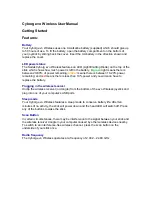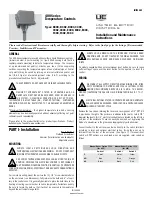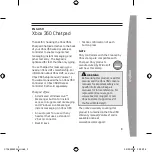
e
e
N
N
o
o
d
d
3
3
-
-
D
D
D
D
i
i
g
g
i
i
t
t
a
a
l
l
d
d
o
o
s
s
i
i
n
n
g
g
c
c
o
o
n
n
t
t
r
r
o
o
l
l
l
l
e
e
r
r
e
Nod3-
D
: User’s instructions
165 752-A
18/23
The following tab recaps the possible cases encoutered when starting a cycle :
automatic
taring at start
restart if
suspended
authorization
weight value
action
min empty weight < gross weight < max empty
weight
regardless the gross weight value IF
min empty weight = max empty weight = 0
taring then start
other case
cycle cancelled,
error reporting
active
allowed
regardless the gross weight value IF last cycle
was suspended
cycle recovery
from last step
(taring possible)
min empty weight < gross weight < max empty
weight
regardless the gross weight value IF
min empty weight = max empty weight = 0
no tare, starting
from the net
current value
other case
cycle cancelled,
error reporting
inactive
allowed
regardless the gross weight value IF last cycle
was suspended
cycle recovery
from last step
(no tare)
11.2 Cycle description
11.2.1 Flow rate control (optional)
e
Nod3-
D
includes a flow rate control system. It makes possible to check that the flow rate during the
cycle is sufficient. The device controls that te flow rate remains equal or superior to a minimal value. If it is
not the case, an output assigned to ‘dosing failure’ or ‘flow rate failure’ is set and the cycle is suspended if
the cycle recovery option is active else it is stopped.
The flow rate control is defined by two parameters :
∗
a time interval (if = 0, the flow rate control is not used)
∗
a minimal weight variation
11.2.2 Automatic taring at start
If the ‘automatic taring at start’ option is active, as soon as the ‘start delay’ has elpased, the tare
acquisition is done if measurements are stable. If at the end of the ‘motion time out’ timer, no stability can
be found, the tare value is equal to the last net current value.
11.2.3 Coarse feed effect neutralization time
This delay defined in millseconds allows to ignore the effect of the coarse feed starting on the
measurement signal and especially the product impact into the receptacle. During this timer, the flow rate
control and the level comparisons are inhibited.
11.2.4 Fine feed level
If the level (target weight – fine feed) is crossed the ‘coarse feed’ output is immediately disabled. It is
ignored if only the coarse feed is used (cf. §7.4).
11.2.5 Fine feed effect neutralization time
This delay defined in millseconds allows to ignore the effect of the coarse feed ending on the
measurement signal and especially the changing in the flow rate. During this timer, the flow rate control
and the level comparisons are inhibited.






































